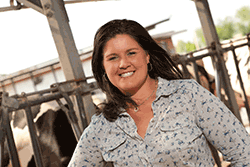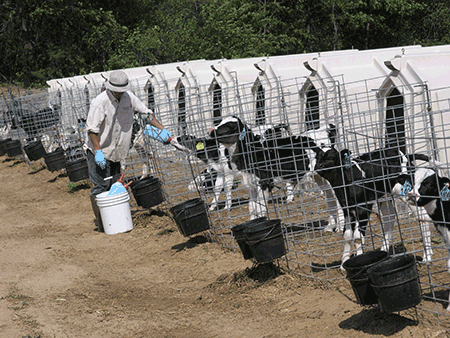
 One of the many goals in raising calves is to provide a stress-free environment, which takes proactive management of the calves' basic needs. These basic needs include: food and water, shelter, comfort, routines and health.
One of the many goals in raising calves is to provide a stress-free environment, which takes proactive management of the calves' basic needs. These basic needs include: food and water, shelter, comfort, routines and health."Changes in any of these basic areas, even seemingly small changes, can make large differences in the overall health and well being of the calves," says Bethany Fisher, a calf and heifer specialist with Purina Animal Nutrition in Texas.
 To evaluate how your operation is doing, Fisher suggests taking a step back and consider the following areas.
To evaluate how your operation is doing, Fisher suggests taking a step back and consider the following areas.1. Food and Water
Offer feed that meets the calves' nutritional needs all year-long. During periods of heat or cold stress, calves need added energy to maintain efficient growth and to allow proper body function. This is important at every stage of life and includes colostrum, milk or seasonal milk replacer and calf starter, formulated for the season.
Milk or seasonal milk replacer needs to be fed at a sufficient quantity to allow the calf to maintain body temperature, double its birth weight, grow 4 to 5 inches in height by weaning and maintain proper immunity.
By day three, water and calf starter needs to be in plentiful supply. Especially in a growing heifer, feed should never be in short supply. Running out of feed or water for any length of time can result in slug feeding and even bloating when feed is finally offered. Neither condition is ideal for efficient gains or optimal health.
Fresh clean water is equally as important as feed. Even if the water freezes overnight, it is important that it is available for calves to drink. It is common for calves to consume more feed in the evening hours between milk feedings, but this will be reduced if sufficient water is not available.
2. Shelter and comfort
The type of shelter calves' have access to, does not have to be fancy or purchased from a catalog or special company. It just needs to provide the animal a place to get out of the elements and should be easy to clean. Use your best judgment to determine what type of shelter is needed for the age group.
Outside of the type of shelter offered other considerations that need to be made to ensure calf comfort include ventilation, bedding and weather.
Hot Weather
- Ventilation ? depending on the type of shelter provided, it is always important to understand the air quality at the calf level. Even something as simple as propping up a corner of the hutch to allow air movement can decrease the heat stress seen by the calves.
- Bedding ? sand is a good option in the summer heat. Bedding allows for added comfort to the calf and provides a barrier between the calf and the ground underneath, which can contain pathogens. It is important to make sure that bedding is always clean and dry, as moist bedding can harbor pathogens and attract flies, especially in warmer weather.
- Calf hutch location - Watch the sunlight throughout the day to determine how to best position housing to reduce heat stress. Also, take advantage of prevailing winds as much as possible.
Cold Weather
- Ventilation - Keeping calf hutch airflow in check during cooler weather help reduce the risk of respiratory problems, such as pneumonia.
- Bedding ? calves should have a nesting score of three ? meaning that when lying down their hocks are not visible. Straw, cotton burs and wood shavings are all accepted bedding types. This bedding will provide added warmth, improved comfort and a barrier between the young calf and the ground below.
- Calf jackets are also very handy in the colder climates. Keeping a calf warm and well bedded allows the calf to utilize the energy it gains from colostrum, milk and grain to grow and develop rather than merely maintain its body temperature.
3. Routine changes
Even the smallest changes in a calf's routine can cause stress, which can lead to health issues, loss of body condition or even death. Stressors include feed changes, weaning from milk, moving pens, weather or relocating from single housing to group pens.
Limiting the number of changes or transitions made at any given time can help reduce calf stress. For instance, if calves are changing pens, wait a few days after the move to change feed. The same idea can be applied when weaning calves from milk and moving into group settings; allow the calves a few days to adjust to not receiving milk before moving them. If vaccinations or dehorning are needed around the time of moving, work with your veterinarian to create a schedule that limits the stress on the animals.
"The overall health of the calves and heifers is greatly influenced by food, shelter, comfort and transitioning through the growth stages," says Fisher. "When these components are addressed, health problems can be reduced greatly in both the heat of summer and the cold of winter."

The next time you walk through your calf and heifer pens, stop and think about the basics. Are they comfortable? Do they have feed and clean, fresh water all of the time? How can I reduce my stress by reducing theirs? At the end of the day we all want the same thing: a healthy calf.
Listen to an audio clip here.
For more information, contact Bethany Fisher at (870) 830-6999, email BLFisher@landolakes.com or visit www.amplicalf.com.
Purina Animal Nutrition LLC (www.purinamills.com) is a national organization serving producers, animal owners and their families through more than 4,700 local cooperatives, independent dealers and other large retailers across the United States. Driven by an uncompromising commitment to animal excellence, Purina Animal Nutrition is an industry innovator, offering America's leading brands of complete feeds, supplements, premixes, ingredients and specialty technologies for the livestock and lifestyle animal markets. Headquartered in Shoreview, Minn., Purina Animal Nutrition LLC is a wholly owned subsidiary of Land O'Lakes, Inc.
3.17.2014